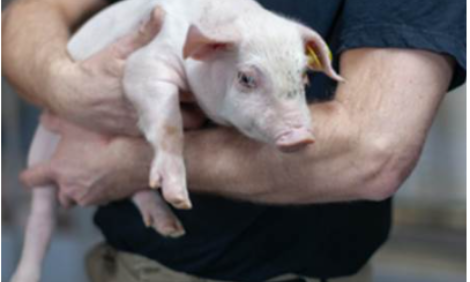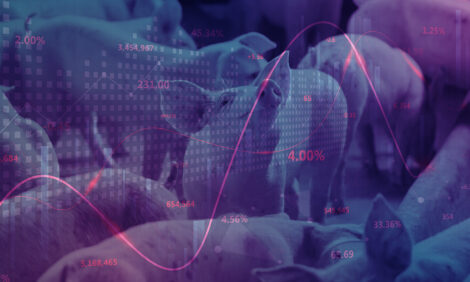



Stressful Handling of Pigs
By Harold W. Gonyou and published by the Prairie Swine Center - 'Downer’ pigs are a problem for both packers and producers. Levels of downer pigs arriving at various U.S. packing plants are typically reported at 0.25 to 0.75 %; however, levels as high as 10 % have been reported for individual loads. The incidence of downer pigs has increased from 0.08 to 0.30 % over the past 10 years. Stressful handling appears to be a triggering factor for the occasional high levels of downer pigs.
Although genetic predisposition has been suggested, the ‘stress’ gene is not a prerequisite for the condition as statistics show 90 % of dead pigs arriving at Canadian packing plants do not carry the ‘stress’ gene. High levels of blood lactate and ammonia, lower blood pH, blotchy skin, open-mouthed breathing, vocalizations, muscle tremors and a refusal to walk are typical symptomsof these animals. The behavioural and physiological symptoms are characteristic of a hyperthermic animal under stress resulting in the typical fight/flight response and attempts to dissipate heat.
The metabolic symptoms are due to the rapid release of energy from either or both the muscle and liver resulting in a build up of lactate and ammonia in the blood. This increase in lactate causes metabolic acidosis, which may be involved in the refusal of the animal to move. In this study we attempted to shift the acid/base balance of the animal by increasing the electrolytes in the diet, hoping to increase the buffering capacity of the blood and reduce the risk of acidosis during stressful handling.
The current model used to study stressful handling of animals is based on handling groups of animals with the understanding that a social stress (unfamiliar animals) as well as frustration during movement due to crowding would represent typical commercial handling situations. Additionally, the electric prod is used in the current stressful model to increase the level of stress since electric prods are believed to be a major source of stress in aggressive handling procedures. In these studies we examined both the need for group handling and the electric prod in the handling model.
Two studies were conducted; using a total of 336 pigs, to determine if altering the acid/base balance of the pigs through diet manipulation would affect the pig’s response to stressful handling and to evaluate features of the model used for inducing stressful handling situations.
The experiments were designed to compare stressful handling (aggressively run through a course within the barn) for individually-run or group-run pigs on either a high or low electrolyte balance diet (Study 1). In addition, comparisons were made between aggressively handled pigs with or without an electric prod compared to gently handled pigs (Study 2).
In Study 1 we had a downer rate of 38%. The results show a decrease in blood pH and an increase in the levels of lactate, ammonia, glucose and glycerol in the blood as well as an increase in rectal temperature in downer pigs compared to non-downers (Table 1). These changes are indicative of the rapid mobilization of energy in downer pigs as a response to aggressive handling. Group-run pigs had lower blood O2 and CO2 and higher blood glycerol post-handling than did individually-run pigs. A higher proportion of downers in the group-run pigs (54%) suggests that group handling of pigs was more effective in inducing downers for model purposes. Altering the acid/base balance of the diet did not affect the pig’s response to aggressive handling in either study. The high electrolyte balance diet raised the pre-handling blood pH in the first experiment but this did not prevent the typical physiological responses to handling and did not affect the incidence of downers.
In the second study, we obtained downer rates of 2, 15 and 34% for pigs handled gently, aggressively but not prodded, and aggressively including electric prodding, respectively. Among the aggressively handled pigs, the use of an electric prod resulted in a greater metabolic response to handling compared to the non-prodded pigs (Table 2). Aggressively handled, non-prodded pigs had higher blood lactate and glycerol levels post-handling than gently handled pigs (Figure 1). This suggests that aggressive handling, even without the use of a prod, may contribute to the ‘downer’ response, but this response is exacerbated by use of the electric prod.
Strategic funding for this project was provided by Elanco Animal Health.
The Bottom line
The use of the electric prod during aggressive handling contributes to the incidence of downer animals.
Aggressive handling of pigs can result in the metabolic response associated with downer pigs.
Altering the dietary electrolyte balance was not effective in reducing the metabolic response of pigs to aggressive handling or the incidence of downers.
handled pigs with or without the use of an electric prod

| Handling Size | Non-downer |
Downer |
| Number of Pigs | 90 |
54 |
| Rectal temperature, Celsius | 40.3 |
41.2 |
| Blood pH | 7.29 |
7.24 |
| Blood lactate(1), mg/dl | 105.6 |
149.3 |
| Blood ammonia(1), umol/l | 89.4 |
143.0 |
| Blood gluclose(1), mmol/l | 8.81 |
10.88 |
| Blood glycerol(1), mg/dl | 39.8 |
50.9 |
(1) Values shown were taken post-agressive handling
and the incidence of downers in agressively handled pigs
| Handling Manner | Gentle |
Aggressive |
| Electric Prod | - |
+ |
| Number of Pigs | 48 |
96 |
| Number of downers (% of total pigs) | 7
(15%) |
33
(34%) |
| Blood lactate(1), mg/dl | 47.1 |
134.5 |
| Blood ammonia(1), umol/l | 36.3 |
123.5 |
| Blood gluclose(1), mmol/l | 5.80 |
9.68 |
| Blood glycerol(1), mg/dl | 39.5 |
48.4 |
(1) Values shown were taken post-agressive handling
Source: Prairie Swine Centre - November 2004








